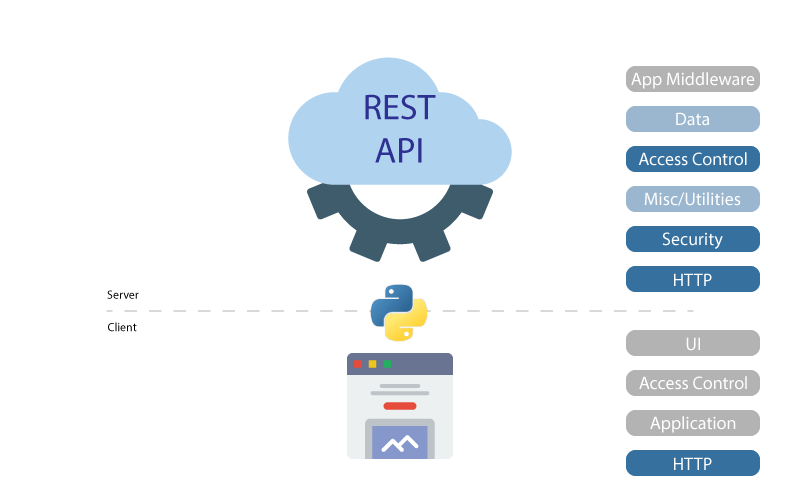How to call the API in Python?
How to call the API in Python?
To call an API in Python, you'll need to use a library that handles HTTP requests, such as requests. Here's a step-by-step guide on how to do it:
Step 1: Install the requests library
If you haven't already, install the requests library by running the following command in your terminal:
pip install requests
Step 2: Import the requests library
In your Python script, import the requests library using the following line of code:
import requests
Step 3: Define the API endpoint and parameters
Determine the API endpoint you want to call, along with any required parameters (e.g., API key, user ID, etc.). For example, let's say the API endpoint is https://api.example.com/data and it requires an API_KEY parameter.
Step 4: Send a GET request
Use the requests.get() method to send a GET request to the API endpoint. Pass in the URL, along with any required parameters:
response = requests.get('https://api.example.com/data', params={'API_KEY': 'your_api_key'})
Replace https://api.example.com/data with your actual API endpoint, and your_api_key with your actual API key.
Step 5: Handle the response
The requests library will return a response object, which contains the API's response. You can access the response status code using the response.status_code attribute:
if response.status_code == 200:
The request was successful!
data = response.json()
print(data)
else:
Handle any errors
print(f"Error: {response.status_code}")
In this example, we're assuming the API returns JSON data. If that's not the case, you can use other methods to parse the response (e.g., XML, CSV).
Step 6: Send a POST request (optional)
If the API requires a POST request, you can use the requests.post() method:
data = {'key': 'value'}
response = requests.post('https://api.example.com/data', json=data)
Replace data with your actual data, and https://api.example.com/data with your actual API endpoint.
Step 7: Handle errors
It's essential to handle any potential errors that might occur when calling the API. You can use a try-except block to catch any exceptions:
try:
response = requests.get('https://api.example.com/data', params={'API_KEY': 'your_api_key'})
except requests.exceptions.RequestException as e:
Handle the error
print(f"Error: {e}")
In this example, we're catching any RequestException errors that might occur when sending the request.
Example code
Here's an example of a Python script that calls an API using the requests library:
import requests
Define the API endpoint and parameters
api_endpoint = 'https://api.example.com/data'
api_key = 'your_api_key'
try:
Send a GET request to the API
response = requests.get(api_endpoint, params={'API_KEY': api_key})
if response.status_code == 200:
The request was successful!
data = response.json()
print(data)
else:
Handle any errors
print(f"Error: {response.status_code}")
except requests.exceptions.RequestException as e:
Handle the error
print(f"Error: {e}")
This code sends a GET request to the API endpoint with an API_KEY parameter, and then handles the response. You can modify this example to fit your specific use case.
Conclusion
Calling an API in Python using the requests library is a straightforward process. By following these steps, you'll be able to send requests to APIs and handle responses. Remember to handle any potential errors that might occur when calling the API, and don't forget to replace placeholders like api_endpoint and api_key with your actual values. Happy coding!
Is Python good for REST API?

I'm happy to respond in English this time!
Python is indeed an excellent choice for building REST (Representational State of Resource) APIs. Here's why:
Ease of Use: Python has a syntax that's easy to learn and use, making it an ideal language for developers who want to focus on building their API without getting bogged down in complexities. Large Community: The Python community is vast and active, with numerous libraries and frameworks available for building REST APIs. This means you'll find plenty of resources online to help you overcome any hurdles or learn new techniques. Flexibility: Python's flexibility allows you to integrate it with various technologies, such as web servers (e.g., Apache, Nginx), databases (e.g., MySQL, MongoDB), and other languages (e.g., JavaScript for client-side development). Rapid Development: Python's syntax and nature make it perfect for rapid prototyping and development. You can quickly create a REST API and test your ideas without spending too much time on setup or infrastructure. Error Handling: Python has excellent support for error handling, which is crucial when building APIs that need to handle diverse client requests. You can catch errors, log them, and provide meaningful responses to clients. JSON Support: Python has built-in support for JSON (JavaScript Object Notation), a popular data format used in REST APIs. This makes it easy to serialize and deserialize data between your API and clients. Security: Python's standard library includes modules for encryption and hashing, allowing you to implement secure authentication and authorization mechanisms in your API. Cross-Platform: Python can run on multiple operating systems (e.g., Windows, macOS, Linux), making it a great choice if you want to deploy your REST API on different platforms.Some popular Python libraries and frameworks for building REST APIs include:

When choosing Python for your REST API project, consider the following:
Scaleability: If you expect a large number of requests or need to handle a lot of data, choose a framework like Flask or Django that can scale with your needs. Performance: Optimize performance by using libraries like NumPy and SciPy for scientific computing, or SQLAlchemy for database interactions. Testing: Write unit tests and integration tests to ensure your API is reliable and behaves correctly under various scenarios.In conclusion, Python is an excellent choice for building REST APIs due to its ease of use, large community, flexibility, rapid development capabilities, error handling support, JSON support, security features, cross-platform compatibility, and the availability of popular libraries and frameworks.